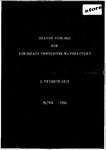HEATED TOOLING FOR AEROSPACE COMPOSITES MANUFACTURE
| dc.contributor.author | PROGOULAKIS, lOSIF | |
| dc.contributor.other | Faculty of Science and Engineering | en_US |
| dc.date.accessioned | 2012-08-03T10:06:35Z | |
| dc.date.available | 2012-08-03T10:06:35Z | |
| dc.date.issued | 2004 | |
| dc.identifier | Not available | en_US |
| dc.identifier.uri | http://hdl.handle.net/10026.1/1105 | |
| dc.description.abstract |
The increasingly high capital investment required for large autoclaves, ovens and facilities for the processmg of large composite components creates a number of financial constraints for the development and manufacturing of larger composite aircraft products. This thesis has investigated the use of heated tooling as an alternative to the use of autoclave and oven curing. A design and development methodology for heated tools has been proposed while a number of heated tooling options have been identified and described. Three representative heated tool options using heater mats, electro-conductive textiles and wire heater elements have been evaluated. The curing capability of a prototype heated tool incorporating wire heater elements has been proved by carrying out a number of curing tests on RFI (Resin Fihn Infusion) laminates. The moulded laminates indicate that a 78-83% extent of cure is achieved prior to post-cure. The fibre and void content of cured laminates has also been verified through acid digestion and microscopy, where an acceptable fibre volume fraction (Vf) of 55-57% and a void content of less than 2% have been achieved. The usefulness of ID and 3D thermal Finite Element Analysis for the design and simulation of heated tooling has also been studied. A manufacturing and cost analysis study carried out has identified potential production implications, while the cost effectiveness of heated tooling compared to oven and autoclave processmg has been indicated. Cost reductions are noted in capital investments, operational costs and production set-up costs per part. The work described in this thesis gives valuable information for the implementation of heated tooling as a new processing method for aerospace composite products. The information can prove useful when considermg the processing options of large composite parts such as wing spars, fan cowl doors and wing skins. | en_US |
| dc.description.sponsorship | GKN Aerospace Services | en_US |
| dc.language.iso | en | en_US |
| dc.publisher | University of Plymouth | en_US |
| dc.title | HEATED TOOLING FOR AEROSPACE COMPOSITES MANUFACTURE | en_US |
| dc.type | Thesis | |
| dc.identifier.doi | http://dx.doi.org/10.24382/4807 |
Files in this item
This item appears in the following Collection(s)
-
01 Research Theses Main Collection
Research Theses Main


